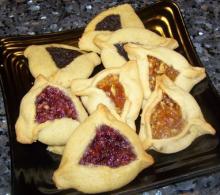The Jewish people have existed for thousands of years and have made homes in various cultures throughout the world. One of the most enduring aspects of this long-lived, globetrotting history is food. Jewish food isn't so much a culinary tradition on its own as it is a sort of Silly Puddy of world cuisine. Wherever Jews have lived, they have picked up local influences in the foods they create. The following are just a few of the many intriguing, tasty and culture-infused foods in the Jewish tradition.
Kreplach
Just about every society on Earth has embraced the simple beauty of the dumpling. From the Chinese won-ton to the Eastern European pierogi, the filled ball of dough is a satisfying and versatile food that has been part of the human diet practically since the invention of refined grain. Kreplach, like a lot of Jewish bread recipes, is made from a rich, eggy dough. The most basic recipes call for small squares of dough to be filled with ground beef or chicken, then folded into triangles and boiled in soup. There are other variations on kreplach, including the hearty potato-filled style and the creamy cheese-filled dumpling usually served for the holiday of Purim.
Hamantashen
Speaking of Purim, these sweet pastries are the favorite symbolic food of the festival. Hamantashen are triangular cookies filled with various flavorings, usually fruit preserves or poppy seed, though more modern recipes allow for everything from chocolate to nut butter. The hamantash cookie represents the villainous Haman, the character in the Purim story who failed in his attempt to eradicate the Jews. Older traditions state that the cookies represent Haman's ears, though that story has been softened recently to equate them with his hat instead.
Pescado Frito
Though a lot of the foods associated with Jewish cuisine in America come from the Eastern European Ashkenazi tradition, there are many great foods that come from the Western Sephardim. One of those tasty recipes is pescado frito, a deep-fried white fish popular with the Jews of southern Spain during the Renaissance. The fish is fried in vegetable oil whole and usually served with fresh citrus, like lemon or lime. The batter for the fish is made from eggs and matzo meal, giving it a distinctly Jewish flavor. This recipe, consistent with the oil-centric cuisine of the eastern Mediterranean, migrated with Jews into Spain and some accounts have the recipe jumping to 19th century England where it was altered and became the famous fish-and-chips meal.
